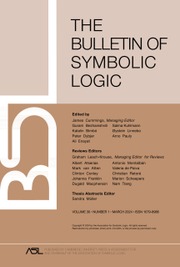No CrossRef data available.
Article contents
A FORMALISATION OF CONSTRUCTIVE EVIDENCE-BASED REASONING: CONSTRUCTING JUSTIFICATIONS
Published online by Cambridge University Press: 03 March 2025
Abstract
A Constructive Logic of Evidence and Truth ( $\mathsf {LET_C}$) is introduced. This logic is both paraconsistent and paracomplete, providing connectives for consistency and determinedness that enable the independent recovery of explosiveness and the law of excluded middle for specific propositions. Dual connectives for inconsistency and undeterminedness are also defined in
$\mathsf {LET_C}$) is introduced. This logic is both paraconsistent and paracomplete, providing connectives for consistency and determinedness that enable the independent recovery of explosiveness and the law of excluded middle for specific propositions. Dual connectives for inconsistency and undeterminedness are also defined in  $\mathsf {LET_C}$. Evidence is explicitly formalised by integrating lambda calculus terms into
$\mathsf {LET_C}$. Evidence is explicitly formalised by integrating lambda calculus terms into  $\mathsf {LET_C}$, resulting in the type system
$\mathsf {LET_C}$, resulting in the type system  $\mathsf {LET_C^{\lambda }}$. In this system, lambda calculus terms represent procedures for constructing evidence for compound formulas based on the evidence of their constituent parts. A realisability interpretation is provided for
$\mathsf {LET_C^{\lambda }}$. In this system, lambda calculus terms represent procedures for constructing evidence for compound formulas based on the evidence of their constituent parts. A realisability interpretation is provided for  $\mathsf {LET_C}$, establishing a strong connection between deductions in this system and recursive functions.
$\mathsf {LET_C}$, establishing a strong connection between deductions in this system and recursive functions.
MSC classification
Information
- Type
- Article
- Information
- Copyright
- © The Author(s), 2025. Published by Cambridge University Press on behalf of The Association for Symbolic Logic


